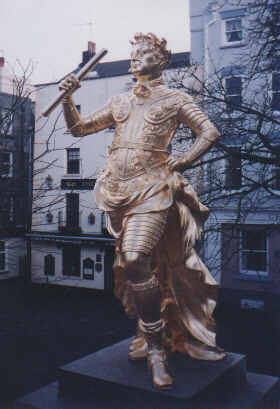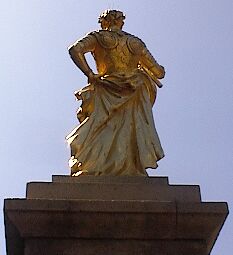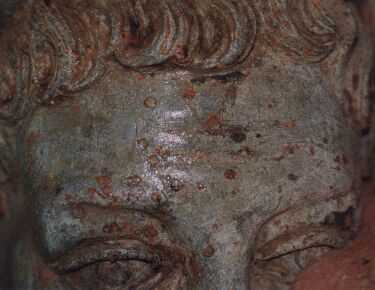


Although much derided over the centuries, this is a perfectly respectable statue of George II, and reminiscent of the two statues of the king in London: by John Michael Ruysbrack at Greenwich (1735), and by John Nost the elder in Golden Square, Soho (erected 1753, actually made 33 years earlier for Duke of Chandos; lead painted white). Both statues depict the king in Roman dress.
THE CEREMONY OF ERECTING THE KING'S STATUE AT JERSEY THE 9TH DAY OF JULY (1751).
A Squadron of Horse with a Captain's Cornet, Quartermaster and thirty Troopers to parade by the Black Rocks at nine a clock in the morning and the five Companies of Fuzeliers parade at the same hour and place, each Company to be made up 48 good men out of their Regiments. The Estate of the Island to be assembled the same morning at ten a clock at Mr. D'Auvergne's house with the Officers of the Garrison and Gentlemen of the Island who please to attend. As soon as they are assembled notice to be given to the Squadron to begin their March with sword drawn and trumpet sounding, to march up through the Great Street, followed by the four following Companies of Fuseliers, Collonel Marett first, Coll. Le Geyt next, Col. la Haute next, then Col. Poingdestre. As soon as this Company is marched through the Gate, the Sergt. and twelve men with their Halbards care to form four in a Rank and March about twenty passes behind them. The Denonciator is to follow carrying the Mace before the Lt. Governor, Lt. Bailiff and Jurats who are to march two and two, then the Clergy and Constables in the same manner, then the officers of the Garrison two and two and the Gentlemen of the Island in the same manner ; in the rear of al1 marchers Cot. des Augrès' Company.
The Squadron is to draw up in a Rank centiur (sic.) behind the Pedestal. Col. Marett and Col. le Geyt's Company are to draw up on the Right of the Pedestal facing the Court House, the other two Companys are to draw up opposite to them and face Mr. Patriarche's Buildings ; leaving a wide lane ; when the Lieutenant Gouvernor, Lt. Bailiff and Estates of the Island come in the middle of the lane of Soldiers, they are to file off and range themselves in a single Line in the front of the Militia upon the right of the Statue, facing the Court House. The Officers of the Garrison with the Gentlemen of the Island are to do the same on the Left of the Statue. As soon as this is done Col. des Augrès' Company draws up in the Interval of the Lane facing the Statue. N.B. As soon as the Lieutenant Gouvernor, Lt. Bailiff come into the Lane the men are to rest their arms, drums beat, the Officers salute. The Sergeant and twelve men with the Halbards are to march strait forwards and when they come near the Pedestal, they are to file and place themselves six on each side of the Pedestal with their arms order'd. As soon as Mr. des Augrès' Company has filled up the part of the Square, the Drums are to cease and the men to shoulder ; then the cases of the Statue is to be taken off, which when done the Deputy Viscount is to proclame aloud that this Statue is erected in honr. of his Sacred Majesty King George the Second, whom God long preserve to reign over us. Then a signal is to be made from the top of the Church to the Castle, on which seven canons are to be fired and followed by a voly from the Companys of Fuseliers ; then seven canons more and the third [sic].voly. After which if they please His Majesty's health may be drank and then the Procession march back to Mr. D' Auvergne's, first the Sergeant and twelve men, then the Denonciator and States, Officers and Gents ; then the Companies of Fuseliers and the troops in the rear.
N.B.-If the Gouvernor is present, the Lieutenant Governor is to be alone at the Head of the Officers of the Garrison. A bunfire on the Hill at night and everybody to be out of mourning this day.
The Adjutant-General to give the words of Command to the five Companies. To give a copy of this Order to be sent to each Colonel a copy of the Governors Order. [sic.].
Monsr. le Général Dauvergne ayant demandé permssion aux États de faire dorer à ses fraix la Statuë du Roi qui est au haut du Marché public & de faire ériger une Ballustrade à l’entour du haut du pied d’Estal, Les États ont accepté l’Offre dudit Sr. Dauvergne & lui en presentent leur Remerciemens.
Actes des États 27/7/1789
M. Le Général D’Averne a proposé de faire dorer à ses frais la statue qui est sur la pyramide et d’en faire entourer le haut d’une balustrade en fer. Les États lui ont accordé sa demande.
Gazette de Jersey 8/8/1789

At the head of the Market Place, upon a pedestal, stands a gilded Statue intended to represent George the Second - the attitude of which is so graceless, and the countenance so unlike, that it has been found necessary to inscribe upon the stone, the name of the personage it was meant to exhibit. The fact is - the States of the Island were duped by an old gentleman of the name of Gosset, who wanting a piece of ground to render a house he was building more commodious - offered, for the grant of it, a Statue of His Majesty to adorn the publick Square. The proposal was accepted & the figure was brought over from England. The site had been previously prepared, and iron rails placed round, to keep off the rude hands of curiosity. A day was fixed for displaying to the Inhabitants the brazen image of their Monarch - it was conveyed to its eminent station under the inscrutable cover of a Blanket - the publick eye became eager to behold the Royal Effigy - the signal was given & the Veil withdrawn - when instead of the British King - Jersey had conspicuously placed in its capital - the Statue of a Roman Emperor.
Mr. Gosset - the patriotic Donor conceiving that his countrymen might be easily duped, and he perform, at a cheap rate, his part of the contract, purchased this old figure of Julius Caesar at a Sale, for its weight in Lead, and added to its ancient dress the decoration of the Garter - as a sure insignium of the expected Monarch - and a certain proof against discovery; but a lady who had recently returned from Rome, visiting the island soon after the erection of this valuable treasure, recognised, to the great mortification of the Natives, the "very stamp and image" of her old friend in the Capitol.
Diary of a Visit to Jersey September 1798 William Taylor Morley
Nous voyons avec plaisir que l’on occupe en ce moment des préparatifs nécessaires pour dorer la statue de la Place-Royale, et pour récrépir ou repiquer les pierres du piédestal. On nous assure que cette double opération doit coûter 15 liv. st., qui seront payées au moyen de souscriptions volontaires. Comme il est beaucoup de personnes qui ne connaissent pas l’époque où cette statue fut érigée, nous avons pensé que l’acte des États qui a rapport à ce sujet ne sera pas lu sans quelque intérêt:
"AUX ÉTATS DE L’ILE DE JERSEY
L’an mille sept cent-cinquante, le deuxième jour du mois de Juin. — Sur ce que par acte des Etats du quinzième de Février 1748, M. Abraham Gosset avait été subrogé au droit de M. Daniel le Preveu, fils Edouard, au sujet de certain marché fait par Contract de vingt-unième jour de Décembre 1720, touchant une Piramide à être érigée dans le Marché Public de cette Ile, ce que ledit Sieur Gosset se serait obligé d’effectuer dans l’espace de deux ans d’allors, sur la pénalité de cnt livres sterling, applicable à tel usage que l’Estat trouveroit convenable; aujourd’hui ledit Sieur Gosset s’étant présenté aux Estats et ayant proposé qu’au lieu dudit Piramide il lui fust permis d’ériger la Statue de Sa Majesté le Roi de la Grande-Bretagne, ladite Statue à être faite de plomb, et dorée convenablement, et qu’il la feroit entourer de balustrades de fer aussi dorées et qu’il la maintiendroit en bon état ‘espace de dix années consécutives depuis son érection, lesdits Estats ont accepté sa proposition et donné audit Sieur Gosset terme d’un an de ce jour pour faire ériger ladite Statue, sur la même peine de cent livres sterling, applicables comme dit est, à quoi il s’est obligé au cas qu’il n’effectuerait ce que dessus est dit dans le temps présentement limité. Le tout à être exécuté au dire de Mons. le Lieutenant-Gouverneur."
Chronique de Jersey 29/8/1846

Rulecour fit ensuite ranger ses troupes sur la place publique, et il leur criait: "Qu’on respecte la statue du Roi George..."
Nouvelle Chronique de Jersey 8/1/1881

Marks of shot on the sculpture's face revealed during restoration 1998 which it is conjectured may date from the Battle of Jersey
The year 1751 saw a change in the Market Place. On July 9th of that year the present statue of George II was unveiled. It stands in all probability on the very spot where once stood the Market Cross, which as we have seen was the place where all public proclamations were made and where the Laws of the States and Ordinances of the Court were promulgated. What became of this interesting relic of antiquity and when it actually disappeared must remain for the present uncertain. We know that the Market Place was paved with stones in 1668. It is possible the Market Cross may have been pulled down at this date whilst the work was being done. An Act of the States of thirty years later dated March 22nd 1697-8, already cited as ordering the removal of "La Cage," refers to the erection in the Market Place of a pedestal which was to support a dial. It was to be fixed on a spot in front of the house of Clement Chevalier, the property formerly occupied by the Chronique Newspaper, and the Act of the States informs us that it was to be an ornament to the Market-Place. There is no indication in the Rolls that this pedestal and dial were to replace the old Market Cross, and whether the pedestal was ever erected must remain doubtful, for 23 years later on the 21st December 1720, we find the States entering into an agreement with a certain Edouard Le Preveu to erect in the Market Place at such spot as would be found most convenient for the public use a column or pillar with pedestal of the Tuscan type, "Une colonne avec un piedestal de l'ordre Toscan." The column was to support a globe. That this column was never erected is quite certain for on November 7th 1748, we find the States deciding to sue Daniel Le Preveu, a son of Edouard Le Preveu, to execute the agreement which his father had entered into with them. Daniel Le Preveu thereupon was permitted to resign his agreement in favour of one Abraham Gosset, who undertook to carry out its provisions. A couple of years later on 2nd June 1750, Gosset was present at a meeting of the States and suggested that instead of constructing a Pyramid in the Market Place, he be permitted to erect a statue of H.M. King George II, the Statue to be of lead and to be gilded, whilst the pedestal was to be encircled by an iron railing, " balustrade," which was also to be gilded. The States agreed, and on July 9th 1751, the Statue was unveiled in the presence of the Lieutenant-Governor, the Militia and a large concourse of the inhabitants. The Deputy-Viscount proclaimed the Statue to be erected in honour of H.M. King George II. The people then gave three cheers and at a signal given from the Church Tower the guns of Elizabeth Castle fired a Royal Salute, answered by a feu-de-joie , from the Militia in the Market Place. Then were brought on the scene many bottles of wine and the King's health was drunk by all the Company present. In the evening there was a general illumination of the Town.
The Town of St. Helier E. Toulmin Nicolle 1931

George II after restoration 1999
